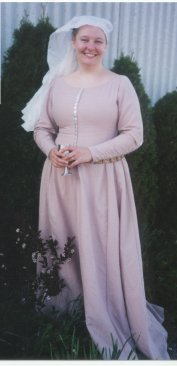Major SourcesIn 1924 Poul Norlund published a book about the discoveries he had made in Greenland. He found a graveyard of people buried around 1350. One of the most amazing parts of this discovery was that much of the clothing they were buried in was almost intact, and could be exhumed and examined. Norlund's book provided scale drawings of the garments, accurate measurements and an interesting commentary on how the garments fit into our conception of fashion history. Some of the clothing found is quite similar to what we think of as cotehardies, and provide the only extant examples of male and female dress of this period. Between 1972 and 1983, a variety of excavations were made around a small
area of London, which seemed mainly to be used as a dump. The items uncovered
in these digs are the subject of an excellent series of books put out
by the Museum of London. The one that is concerned with cloth artifacts,
called Textiles and Clothing (T+C), is an exhaustive look at the fragments
that were found in these areas, which seemed to have Why should these sources be used in combination? There are a number of similarities in the shape of the garments found in both of these places. The lower, fitted half of the sleeves in London are very similar in shape and finish to those in Greenland. Similar types of fabric buttons are found in both Greenland and London. The stitches used in construction of the garments are quite similar in both digs. Archeological dating puts both the Greenland and London sites at about the middle of the fourteenth century. Please note: I am not in any way trying to say that this is the only way to make a Cotehardie type garment. There are a number of ideas that I have come in contact with and tried over the years. This is the one that works best for me to date. The gowns in Greenland are not extremely fitted garments, but they do follow the curves of the body in a number of cases. They might be more analogous to mid century designs, or lower class designs. However, if they are fitted carefully to the body, a very similar drape to the one seen in manuscript paintings etc., can be obtained. It is possible to make one that is fitted enough to support up to a DD cup without modern undergarments. |
 been
used mainly as dumps. The book provides many clear pictures of the actual
pieces, with descriptions of the cloth and stitches.
been
used mainly as dumps. The book provides many clear pictures of the actual
pieces, with descriptions of the cloth and stitches.